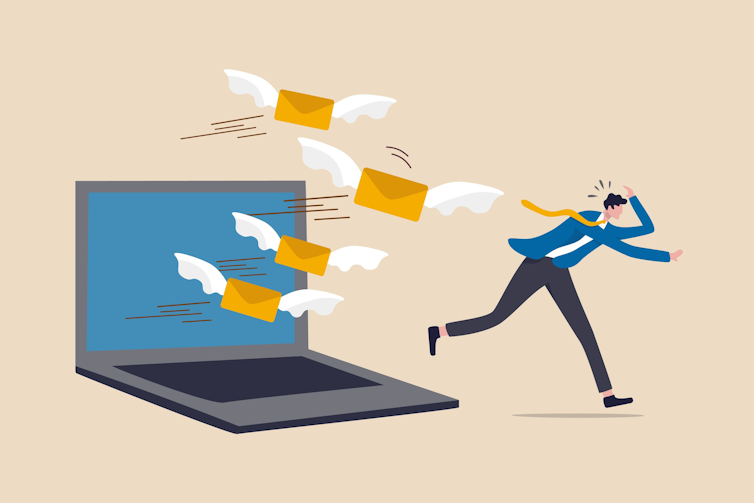Mental Health Week, which runs from May 1 to 7, provides an opportunity to reflect on our collective well-being. In addition to rising mental health issues, there seems to be a general malaise across normally well individuals in society. This is manifesting as cognitive and physical exhaustion, limited patience, disinterest in work and a resentment of the stressors in our lives.
Many of these stressors may be coming from interactions with technology: small but frequent frustrations that quickly dissipate, but when added up become micro-aggressive tech-triggers of digital distress, defined here as a form of psychological distress caused by a dysfunctional user experience with technology.
Tech-triggers are pervasive, yet seemingly innocuous because we’ve learned to click them away or compartmentalize their effects. No one is going to do anything about them until we acknowledge their harm, and that it’s a problem. Here are three main types of tech-triggers and their corresponding effects to consider if this is affecting you.
Pop-ups & prompts — I’m lost!
Pop-ups are designed to interrupt and draw our attention through notifications, calendar reminders, software updates, website ads, low-battery alerts and more. Frequent disruptions put us on high alert like a jack-in-the-box, triggering a release of adrenaline, norepinephrine and cortisol. These chemicals are designed to make us be alert and ready to protect ourselves when we are under threat; but when we are not in actual danger, they just make us feel like we’re on edge.
Prompts for our username and password can be the ultimate trigger. With many people having login details for numerous websites, it can be challenging to keep track of it all. And often, trying to log into one of your accounts can feel like an oppressive regime of trial and error, sifting through your memory for ludicrously jumbled passwords and immemorable usernames.
Keeping such things in our heads is antithetical to the way our memory works, and repeat, failed attempts can create the same psychological state as being lost. The state of being psychologically lost involves feeling isolated, uncertain and disoriented.
With too many pop-ups and prompts, we may be in constant fight or flight mode. It’s no wonder they make us feel lost and jumpy.
Many of the stressors we face come from our interactions with technology. (Shutterstock)
Digital clutter — I’m failing!
Digital clutter creates a slow-burn of deep-seated awareness that there is too much to manage, and we’re failing at it. Unclearable email queues, cluttered digital folders and our inability to complete tech-tasks (like printing photos or deleting old drafts) can create a psychological state of failure. Organizing and decluttering is our way of feeling in control, but sometimes there is just so much to manage. It can feel defeating.
So, too, can the infinite scroll feature on social media apps. Long sessions of scrolling, swiping and tapping make our brain check out and send neurochemical signals of demotivation and failure.
This may be a combination of rising cortisol and lowering dopamine, which creates a biophysical experience of feeling stressed and bored at the same time.
This might be amplified by the frequent failure experienced with other tech-triggers, such as disruptive software updates and continuously newer versions of tech, just different enough to make you feel like you don’t know what you are doing.
This constant state of upgrade is antithetical to how we learn. Humans are motivated by growth: we like to learn more and get better at tasks, not to feel suddenly stupid and slowed down. With too much to sort through and more on the way, our system is frequently triggered for failure. It’s no wonder we feel overwhelmed.
Cyber insecurity — I’m afraid!
A third tech-trigger is caused by apprehensions about our cyber-security and how safe our digital information really is. Although online shopping and banking seems secure, there can be a sneaking suspicion that our credit card and financial information are not as protected as we’re told. We manage this fear with a few clicks, or perhaps with a purchase that restores our sense of control.
Terror management theory suggests that societies gain comfort through avoidance. Is it possible people click “allow all” on cookie notifications to make themselves feel better? If so, the same theory explains how this can also trigger existential anxiety and depression. With so much at stake, our system is frequently triggered to feel unsafe, and it’s no wonder our brain is warning us to stay alert.
Digital clutter creates a slow-burn of deep-seated awareness that there is too much to manage, and we’re failing at it. (Shutterstock)
What can we do about it?
The effects of these tech-triggers mean we might regularly feel lost, stupid and afraid. The question is: what can we do about it? Many of these interactions are embedded in our work and lifestyles and yet, our bodies and minds are telling us this isn’t right.
Digital distress may be our body’s way of warning us that something’s got to change. If so, awareness is a start, and can help us better manage the situation and regulate our responses. Here are a few things you can try:
• Take the time to review your settings for pop-up blockers, cookies, authorized data access and notifications. Turn them off (or better yet, set a time to turn off your devices) and see if you feel more calm.
• Schedule time for sorting through digital clutter before it becomes overwhelming (or better yet, consider what you want to receive or save in the first place). If you don’t deal with it now, you’ll have to deal with it later with more stress.
• Stay alert for workplace tech-triggers and challenge them when they first arise. Some so-called solutions are problematic, like having to log in to the same account repeatedly throughout the day or having to go through too many authentication steps. Employers might reconsider tactics if employee mental health is on the line.
We can also create small changes that make us less tech-dependent, such as bringing back wall clocks so we can glance at time without a screen; noting schedules on paper to avoid being drawn into email via our digital calendar; and change our settings in apps and devices to have more control over our digital experience.
Small, proactive countermeasures can increase our self-efficacy in a way that will reduce our digital distress and make us feel more empowered over our mental health.



 Merck Nears Acquisition of Cidara Therapeutics at Significant Premium
Merck Nears Acquisition of Cidara Therapeutics at Significant Premium  China to Add Eli Lilly’s Mounjaro to National Health Insurance in 2025
China to Add Eli Lilly’s Mounjaro to National Health Insurance in 2025  U.S. and Rwanda Sign $228 Million Health Partnership to Boost Self-Reliance
U.S. and Rwanda Sign $228 Million Health Partnership to Boost Self-Reliance  FDA Names Tracy Beth Høeg as Acting CDER Director After Richard Pazdur Announces Retirement
FDA Names Tracy Beth Høeg as Acting CDER Director After Richard Pazdur Announces Retirement  Major Drugmakers Slash U.S. Prices and Sell Directly to Patients Amid Trump’s Push for Affordable Medicines
Major Drugmakers Slash U.S. Prices and Sell Directly to Patients Amid Trump’s Push for Affordable Medicines  Obamacare Premiums Set to Double in 2026 as Subsidy Expiration Looms Amid U.S. Shutdown
Obamacare Premiums Set to Double in 2026 as Subsidy Expiration Looms Amid U.S. Shutdown  Novo Nordisk Appoints Greg Miley to Lead Corporate Affairs Amid U.S. Drug Pricing Pressure
Novo Nordisk Appoints Greg Miley to Lead Corporate Affairs Amid U.S. Drug Pricing Pressure  U.S. Reveals 2026 Medicare Star Ratings: Aetna, UnitedHealth Lead in Quality Scores
U.S. Reveals 2026 Medicare Star Ratings: Aetna, UnitedHealth Lead in Quality Scores  Pfizer Boosts Bid for Metsera Amid Intensifying Rivalry with Novo Nordisk in Obesity Drug Market
Pfizer Boosts Bid for Metsera Amid Intensifying Rivalry with Novo Nordisk in Obesity Drug Market  Eli Lilly’s Weight-Loss Pill Nears Fast-Track FDA Approval as Profits Surge on Global Demand
Eli Lilly’s Weight-Loss Pill Nears Fast-Track FDA Approval as Profits Surge on Global Demand  U.S. Experts to Reassess Newborn Hepatitis B Vaccination Guidelines Amid Growing Debate
U.S. Experts to Reassess Newborn Hepatitis B Vaccination Guidelines Amid Growing Debate  Novo Nordisk Appoints Greg Miley as Global Head of Corporate Affairs Amid U.S. Pricing Pressure
Novo Nordisk Appoints Greg Miley as Global Head of Corporate Affairs Amid U.S. Pricing Pressure 


































